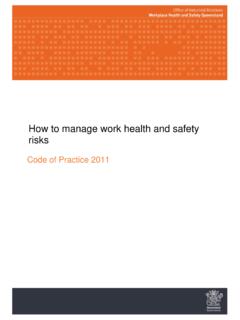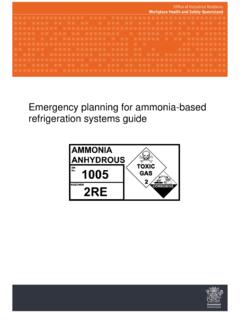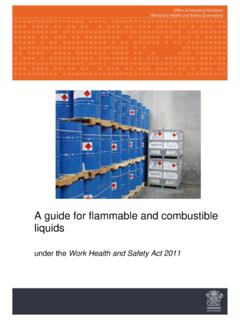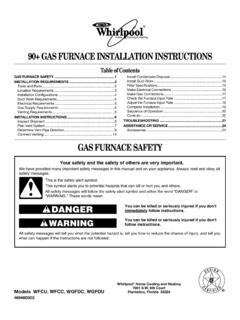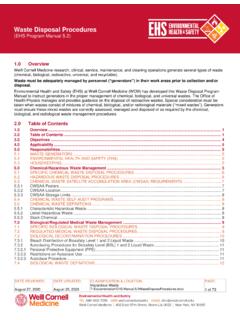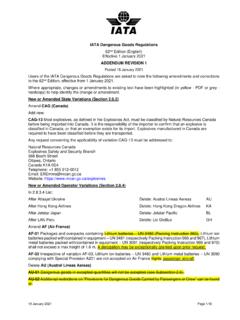Transcription of Guide for handling cytotoxic drugs and related wast
1 Guide for handling cytotoxic drugs and related waste PN10522 Version 4 Last updated February 2017 Guide for handling cytotoxic drugs and related waste 1. Contents Chapter 1: Introduction .. 3. Chapter 2: Legal requirements .. 6. Chapter 3: Managing risks .. 10. Chapter 4: Training .. 17. Chapter 5: Personal protective equipment (PPE) .. 19. Chapter 6: Personnel management .. 25. Chapter 7: Drug preparation .. 30. Chapter 8: Drug administration .. 37. Chapter 9: Risk management in healthcare facilities .. 41. Chapter 10: Risk management in community settings .. 43. Chapter 11: cytotoxic contaminated laundry .. 49. Chapter 12: Spill management .. 52. Chapter 13: Waste management .. 55. Chapter 14: Drug administration in veterinary practice .. 60. Appendix 1 - Glossary of 65. Appendix 2 - Commonly used cytotoxic drugs .. 69. Appendix 3 Legislation .. 71. Appendix 4 Sample cytotoxic drugs register .. 72. Appendix 5 Sample risk assessment of hazardous 73.
2 Appendix 6 Sample audit checklist .. 76. Appendix 7 Training modules for working for cytotoxic drugs .. 80. Appendix 8 Guidelines for health monitoring for cytotoxic drugs .. 85. Appendix 9 Excretion times of some cytotoxic drugs .. 87. Appendix 10 Further information .. 88. This Guide has primarily been updated to reflect recent legislative changes in Queensland and does not represent a review of technical content. It is proposed that a full review of this Guide will be carried out at a later time. Some changes to this Guide were adapted from the Safe handling of cytotoxic drugs and related Wastes: Guidelines for South Australian Health Services 2012 produced by SA Health. The material presented in this publication is distributed by the Queensland Government for information only and is subject to change without notice. The Queensland Government disclaims all responsibility and liability (including liability in negligence) for all expenses, losses, damages and costs incurred as a result of the information being inaccurate or incomplete in any way and for any reason.
3 State of Queensland 2018. PN10522 Version 4 Last updated February 2017 Guide for handling cytotoxic drugs and related waste 2. Chapter 1: Introduction cytotoxic drugs are intended primarily for the treatment of cancer. They are known to be highly toxic to cells, principally through their action on cell reproduction. Many have proved to be carcinogens, mutagens or teratogens. Patients receiving therapeutic doses of these drugs have exhibited a long list of acute and chronic adverse effects, including cancers. Workers who come into contact with cytotoxic drugs and related waste are also at risk of exposure and possible adverse effects. cytotoxic drugs are used in a variety of healthcare settings, in laboratories, manufacturing and research facilities and veterinary clinics. As well as their application in the treatment of cancers, cytotoxic drugs are also being used for the treatment of other medical conditions such as multiple sclerosis, psoriasis and systemic lupus erythematosus.
4 These drugs are also applied topically in ophthalmology for an increasing number of indications. Purpose, scope and application The Guide for handling cytotoxic drugs and related waste applies to the clinical use of cytotoxic drugs and related waste. The purpose is to give practical advice on how to prevent or minimise occupational exposure to cytotoxic drugs and related waste. Use of cytotoxic drugs and related waste includes preparation, administration, handling , storage, movement and disposal. The Guide is intended to assist a person conducting a business or undertaking (PCBU) and others who have duties with respect to cytotoxic drugs . It is meant to act as a tool to assist in the development of necessary policies and procedures to ensure the health and safety of workers and others who may be exposed, and to provide information about legislative requirements. In addition to primary healthcare settings such as hospitals, the Guide is applicable to general practice and medical centres, community care, commercial laundries, veterinary practice, and waste management.
5 Appendix 1 provides a glossary of many of the terms used in this Guide . Some currently used cytotoxic drugs are listed in appendix 2. Legislation to protect workers The Work Health and Safety Act 2011 (the WHS Act) outlines the general health and safety duties of PCBUs, officers of companies, unincorporated associations, government departments and public authorities (including local governments), workers and other people at a workplace. These general duties require the duty holder to ensure health and safety, so far as is reasonably practicable, by eliminating risks to health and safety. If this is not possible, risks must be minimised so far as is reasonably practicable. Chapter 2 outlines legislation applicable to the safe use, storage and handling of cytotoxic drugs . Occupational exposure Little is known of the specific long-term effects of occupational exposure to cytotoxic drugs and related wastes.
6 However, there is sufficient evidence to indicate adverse health effects may result and that measures are required to protect workers and others. In the workplace, exposure to cytotoxic drugs and related waste may occur where control measures fail or are not in place. Workers may be exposed during drug preparation, drug administration, patient care activities, spill management, waste disposal, when handling patient body substances and when handling cytotoxic contaminated laundry. For the purposes of this document, body substances' has been defined as urine, faeces, vomitus, bile, and fluid drained from body cavities'. Where there is a risk of exposure to blood, workers should adopt standard precautions. PN10522 Version 4 Last updated February 2017 Guide for handling cytotoxic drugs and related waste 3. Effects of exposure Where control measures are not adequate, adverse health effects may result from occupational exposure to cytotoxic drugs and related waste.
7 Various studies have been conducted with people preparing and administering cytotoxic drugs . Some of the reported effects include: contact dermatitis, local toxic or allergic reaction may be as a result of direct contact with skin or mucous membranes cytogenic abnormalities and mutagenic activity related to biological uptake by exposed workers alterations to normal blood cell counts excretion of the drugs or metabolites in the urine of exposed workers abdominal pain, hair loss, nasal sores and vomiting liver damage fertility changes foetal loss and malformations of the offspring of exposed pregnant women. Exposure routes Exposure to cytotoxic drugs may occur through: inhalation ingestion dermal absorption mucosal absorption percutaneous injury. Activities where there is a risk of exposure Exposure may occur when: preparing cytotoxic drugs handling cytotoxic drugs in liquid, solid or cream form during administration handling cytotoxic drug containers handling a treated patient's body substances handling or emptying a treated patient's bedpans, urine bottles, urinary catheter bags, ostomy bags, nappies and vomitus bowls or bags handling bed linen or clothing soiled with a treated patient's body substances, or potentially contaminated with unchanged drug or active metabolites cleaning spills or leakages of cytotoxic drugs and related waste.
8 Workplaces Exposure to cytotoxic drugs and related waste may occur in a wide range of workplaces including: hospitals, day hospitals, doctors surgeries, medical practices pharmacies hospital and community commercial cytotoxic drug manufacturers analytical or research laboratories residential care homes homes of patients veterinary clinics vehicles, including ambulances, pharmacy and pathology courier services, waste collection vehicles laundries hospital and commercial mortuaries and funeral homes waste disposal facilities. Exposure standards for occupational exposure There are no exposure standards for acceptable levels of exposure to pharmaceutical products as there are for other hazardous chemicals, such as lead, therefore control measures should be implemented to reduce exposure to levels as low as reasonably achievable' (ALARA). PN10522 Version 4 Last updated February 2017 Guide for handling cytotoxic drugs and related waste 4.
9 Research has shown good work practices and properly implemented control measures significantly reduce exposure, and, consequently, the risks of adverse health effects. Standard operating procedures for the handling of cytotoxic drugs and related waste A standard operating procedure (SOP) is a set of instructions or steps to be followed to complete a job safely and in accordance with legal, operational and company or institutional requirements. SOPs should be written for any process an individual or group performs. SOPs are an administrative control measure. This Guide provides a range of SOPs on a number of issues relating to the use and handling of cytotoxic drugs and related waste. It is intended users of the Guide consider the information provided, and select or adapt the procedures or control measures to develop their own SOPs, which are specific to the particular workplace or workplace activity. SOPs are provided at the end of each chapter.
10 Effective use of SOPs involves: development of safe work procedures and SOPs in relation to implemented control measures. Management, supervision and worker responsibilities may need to be clearly defined in the work procedures communication to inform workers and others about the procedures to be implemented. It is important to clearly communicate the reasons for any changes providing training and instruction for workers, supervisors and others in relation to the procedures providing adequate supervision to verify SOPs are being used correctly maintenance of SOPs to ensure their ongoing effectiveness. Importance of SOPs Standard operating procedures: provide workers with the safety, health, environmental and operational information required to perform a job properly and safely provide a procedure compliant with company and government regulations provide an explanation of a process that can be reviewed when an incident occurs ensure consistency and quality control assist in protecting the health and safety of workers and others.

